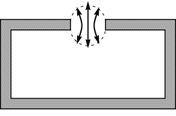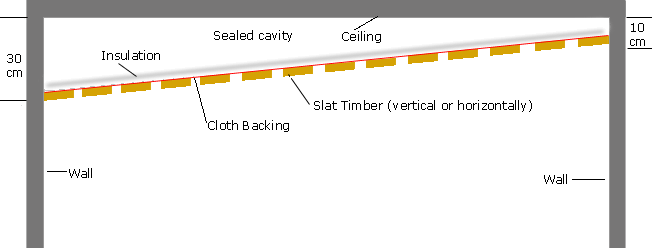


|
Panel Absorber -
Helmholtz Panel Absorber -
Slot Absorber Placing the Traps - Skyline Diffusor Quadratic Residue Diffusor (Size) |
|
There are two commonly used traps, both of which are easy to build. They are
the panel absorber and the Helmholtz resonator. However, to be successful you
first have to know precisely where your problem frequencies are and then you
have to build these traps accurately to ensure that they work at the right
frequency. Both types of absorber take up a large area, but have the advantage of being only a few cm deep. Even so, you must bear in mind that these are tuned traps and so are normally used to reduce specific resonances. They are not suitable for use as broad-band absorbers, with the exception of a panel trap constructed with a highly damped, limp membrane. |
Helmholtz Absorber |
|
| A Helmholtz absorber is simply a box with a port on its front side to couple the enclosed volume of the airspace in the box to the air in the room. The depth of the enclosed airspace in the box behind the port and the width and depth of the port control the resonant frequency of the bass trap. | |
| Another form of helmholtz resonator is created using perforated plywood - i.e. plywood with hundreds of holes in it. You see it in hardware stores holding up tools etc. If you place a panel of this over an air cavity like in a panel absorber not only do the little holes act like bottle necks the whole panel acts as a low frequency panel absorber! | |
 |
|
Standing waves occur at harmonics of the fundamental frequency - that is 2, 3, and 4 times the fundamental. Thus a room with an 2.45 meter ceiling has standing waves forming at 70 Hz (the fundamental frequency or first harmonic), 140 Hz (the second harmonic), 210 Hz (the third harmonic) and 280 Hz (the fourth harmonic). Rooms with smaller dimensions often have standing waves or resonance build ups that are very noticeable causing coloration at around 200 Hz. |
|
|
|
|
The formula for determining the fundamental frequency of a standing wave for a particular room dimension is: fo = V / 2d where: fo = Fundamental frequency of the standing wave V = Velocity of sound (345 meter per second) d = Room dimension being considered in meter (length, width, or height) |
|
The formula for determining fres: fres = c/2 * sqrt( (l/lx)^2 + (m/mx)^2 + (n/nx)^2 ), with l,m,n = 0,1,2... c = 345m |
|
Panel AbsorbersA panel absorber is created when you place a sheet of plywood or fibreboard, with insulation glued to the back of it, over an air cavity. The panel will have a resonate frequency of its own, tap it and you will hear it. When it is placed over a sealed cavity, and insulation is attached to the back, everytime it hears its own note it resonates and the air in the cavity resonates and the insulation absorbs the resonance, hence absorbing the frequency! It is important to note that here we have an absorber that reflects the high frequencies and attenuates the low. With the hangers all that exposed insulation absorbs the high frequencies as well so the panel absorber has a place in the studio. The two factors determining the frequency of absorption are:
 Filling the cavity with fibreglass or mineral wool tends to lower the resonant frequency by up to 50 per cent as well as doubling the effectiveness of the trap. It also lowers the Q of the trap so that it is effective over a wider frequency range. A typical panel-type trap is effective for frequencies around one octave either side of the centre frequency, which at least has the advantage that you don't have to be absolutely accurate to get results. |
|
You can discover the resonant frequency by sticking a cheap contact mic on to the panel's surface, then plugging the mic into a preamp or mixer with a VU meter. Play a test tone from an oscillator or test tone CD using loudspeakers, and vary this around the frequency the trap is designed for until you get a maximum meter reading. This will be at the trap's resonant frequency. How to build a contact microphone |
 |
Helmholtz Panel Absorber |
 |
|
By fixing a perforated wooden panel over a frame and putting an
absorbent material inside the space created, a resonant bass trap is
formed with each perforation acting as a single 'bottle' in our virtual
bottle array. By varying the percentage of perforation, the design can be applied to both the bass and mid range. However, predicting the performance of these traps is difficult because the Q or bandwidth varies depending on the amount of internal damping. The other problem is getting the right perforation percentage. Common hardboard is usually used in mid traps rather than bass traps. For example:
Fixed over a 10 cm air gap, this gives a resonant frequency of a little onder 160 Hz. |
Slot Helmholtz Resonator |
| If
the gaps vary say 5mm, 10mm, 15mm, 20mm and the wall is angled as shown
below, a broad band low mid absorber is created that still keeps the
high frequencies alive. Remember the cavity behind must be airtight!  |
| By working out the different slat widths and slot gaps you can create a broadband low mid absorber at specific frequencies. |
Placing the Traps |
|
The first pair of traps should be
inserted in the front corners of the listening room behind the loudspeakers.
Care must be taken to use the trap only for its intended purpose: pressure absorption. The next pair of traps should be placed in the rear corners behind the listening position. It is common to place larger traps in the rear corners and smaller traps in the front corners. However, if your listening position is at or forward of the room's midpoint, place the larger set of traps in the front corners. The next, and usually final, step is to put one trap at the midpoint of the front wall. This trap, often referred to as the imaging trap, helps tame cross-correlated reflections and takes care of the room resonance which occurs at the midpoint of any of a room's walls. |
| Disclaimer |
| Please keep in mind that I am not an expert or an authority on acoustics, and the information presented here is just my opinion. I do however have many years of practical experience and my opinion is based on that. Please take this information for what it's worth and hopefully you will find it useful. |